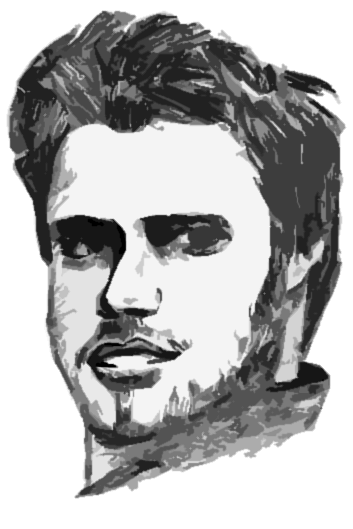The Persistence of Vision
I'm learning all sorts of stuff about images whilst prepping for some comic projects. I've been reading John K's stuff on his blog, which he updates so prolifically and regularly I am actually starting to sympathise with readers of my own blog. The guy is a genius with pretty strong convictions.
Anyway, Animation is pretty useful for comics, particularly when my challenge #1 is:
Challenge Number 1: Draw characters who don't change proportions between every panel.
So in animation you would have a character walk around on a page, 'turn around' through rotations, tilt their head from side to side and then walk towards the 'horizon' and away from the 'camera' and away from the 'horizon' and towards the 'camera' and even though its all just lines drawn on paper, people would believe it, that an image suspended in the air the distance at all times from the viewers eyes have a picture of a person that is moving closer and further away.
Except it shouldn't be remarkable because movies do the exact same thing, its all just static images being rolled passed a globe.
Aparantly movies and animation work thanks to the 'persistence of vision', probably best demonstrated by the disc with a bird on one side and a cage on the other. When you pull on twisted strings on either side the disc spins around and it appears the bird is inside the cage. You know what I'm talking about 'course you do eat the pudding!
Both the bird and the cage image leave a faint lasting impression on the retina that allows ou to percieve that the images are occuring simultaneously even though that's a physical impossibility.
Same deal, with a movie, it's like people running past you with a whole bunch of painted portraits painstakingly painted photorealistic portraits all slightly changed from one another. If the people holding the frames run fast enough and are consistent in height you won't see 300 paintings in a minute, you will think you see 1 moving image.
Where it is interesting to comics, and animation is particularly instructive is that animation and movies are lazy crutches for our brain, because a comic demonstrates that the mind doesn't need 5 frames per second or whatever to be smooth, you can have like 1 panel per 5 seconds and the mind will fill in the blanks and, with enough skill the illusion of being within the story experiencing it in real time will happen without anybody even noticing that they are reading a story.
I guess that's why Scott McCloud defines comics as 'sequential art telling a narrative through time'.
And I'm starting to think that movies are in fact the poorer cousin of comics and not the other way round. James Cameron can play around with CGI 3D renders and it is genuinely impressive. But it's like Gene Simmons talking about the stampede into 5-string bass guitars he was saying 'I haven't mastered 4-strings yet, that guy from The Presidents of the USA plays a 2 string.'
I figure the only reason to learn animation at this stage is to help me learn for the static comic image. We haven't mastered the static image, yet comics have a bunch of tricks. You have the physical limitation of the page - for sure movies are the same you have the landscape dimensions of a screen or widescreen or IMAX or whatever, but just as you cant draw 5 frames per second in a comic and sync a soundtrack to it, you couldn't jam 9 panels onto a movie screen and have the audience follow them, or move through time in the sequence you want them to.
I think the ability to jump from 2d to 4d without necessarily having the 3d worked out yet is amazing. (which technically if you have height and width, no depth, but time you are working in 3d just not the traditional 3d).
But my mind is most blown away by this picture:
Now while this may appear to just be a picture of space akin to looking up into the night sky (in the country not the city), it really is, pretty much like that. Except with a million seconds of exposure time. In this image we have the dimensions of height, width and... time. How much time 13 billion years to be exact.
I'm 26 years old, so 13 billion years is pretty inconcievable but there it is 13 billion years worth of light arriving simultaneously to create this 'ultra deep field image'. It maps 13 billion years into one static image. It takes 8 minutes for sunlight to arrive at earth (give or take) but this image will have light that has been traveling for 1 billion years, or 600 million years or whatever and then the oldest is a redish star buried in there that is from when the universe was only 500 million years old. Which is to say, in that one patch of sky we have light that is 13 billion years old, just traveling from a source through space dodging every possible obstruction and arriving in the vacinity of earth.
So thats what a 2d image can do. 2010, pff.

No comments:
Post a Comment